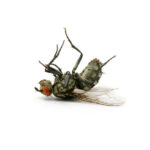Flies in Your Bin?
There are over 7,000 species in Britain belonging to Diptera, the order of True flies, of which a minority are domestic or commercial pests. The problem of fly infestation is acute during the warmer months. However, some specimens can survive the colder months inside heated buildings. Flies can spread disease in food preparation, storage and processing areas due to their proximity to rotting meat, faeces and other unsanitary matter.
Complete metamorphosis: the four-stage fly life-cycle
The winged fly represents the imaginal, or adult, phase of the holometabolous life-cycle known as complete metamorphosis. Adult flies mate, and the female will lay fertilised eggs on an appropriate food source for maggots when they are hatched, such as faeces and decomposing flesh. When larvae have fed enough and grown to a proper size, they will enter the pupal phase from which they shall emerge as adults, completing the four-stage life cycle.
Housefly infestation
Musca domestica, the Housefly, is the most common species of fly to infest British homes, with an estimated 91% of all fly infestations being caused by this species. Houseflies are found in domestic and commercial buildings. They are as likely to be found on food, kitchen surfaces and eating utensils as they are in bins, spreading harmful microbes. Eradication of breeding housefly populations in buildings and waste disposal areas requires the services of professional pest controllers.
Green bottle and blue bottle infestation
 Green bottles comprise several blowfly species with metallic green bodies. Phoenicia sericata, the Common green bottle fly, is the most likely species to infest human properties. Calliphora vomitoria, the Bluebottle fly, is another species of blowfly involved in a residential and commercial fly infestation. Green bottles and blue bottles, whose maggots feed on dead flesh, gravitate towards bins containing decomposing meat, which attract egg-laying females.
Green bottles comprise several blowfly species with metallic green bodies. Phoenicia sericata, the Common green bottle fly, is the most likely species to infest human properties. Calliphora vomitoria, the Bluebottle fly, is another species of blowfly involved in a residential and commercial fly infestation. Green bottles and blue bottles, whose maggots feed on dead flesh, gravitate towards bins containing decomposing meat, which attract egg-laying females.
Treating fly and maggot infestations
When a fly finds a source of food for its maggots in bins – indoors or outside – it lays its eggs there, causing an infestation in the chest and throughout the surrounding area. Likewise, a fly may enter through open doors and windows. However, when these insects begin to reproduce indoors, the population can skyrocket in a short time. Therefore, fly and maggot control should be left to the experts. Young’s Pest Control provides professional solutions to fly infestations in domestic and commercial environments.

